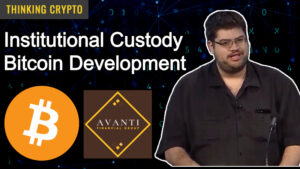Here is my interview with Eric Chen who is the CEO and co-founder of Injective Labs and core contributor to Injective. In this interview we discuss how you can build and use the best Web3 applications on Injective, and how this layer 1 blockchain is shaping the future of finance. We also touch on investments received from Mark Cuban and other investors, FTX collapse, crypto bear market and more.
Transcription
Welcome back to the “Thinking Crypto” podcast, your home for cryptocurrency news and interviews. With me today is Eric Chen, who’s the CEO and co-founder of Injective Labs. Eric, great to have you on the show.
- Thanks for having me.
- Eric, excited to speak with you about Injective. I’m curious about the solutions and services you all are bringing to the table, and you’ve had some very big investors such as Mark Cuban, Pantera Capital, and so forth, but let’s start with your background, where are you from and where’d you grow up?
- Yeah, so grew up in just kinda like different places. Mainly spent my time in Bay Area, so definitely got really, really exposed to the tech scene over there. Also, caught between different regions like Hong Kong, Colorado, et cetera. So certainly quite a lengthy story on a single question.
- What did you do before working at Injective?
- Yeah, so basically I was mainly working on research, specifically around some of the interesting cryptographic primitives, and also on the side helping out a fund working as a trader.
- Okay, so were you trading equities and things like that? Traditional financial?
- It’s a mix, but generally I would say like the majority of time, definitely more crypto.
- And what was your first encounter with crypto and what was your “aha” moment?
- I would say there’s been multiple occurrences, or run-ins with crypto before I decided to go into it full-time. I think very first time it was mainly around exploring the dark web et cetera way back in the day. And then later on kind of running into folks who were really, really excited about Ethereum and learning more about kind of like the underlying technology, et cetera. And also got really, really exposed to the scene in New York at that time, with a lot of people working on different types of solutions, and kind of getting in touch with the first set of really crypto-native people.
- Let’s talk about Injective. Can you tell us about Injective, give us an overview, and what makes it different from other blockchains out there?
- Yeah, so Injective is kinda like a sector specific layer-1 blockchain for finance. Obviously in this case definitely a lot more DeFi applications and a lot of financially tailored, or financial-focused applications as well. And it’s built using the Cosmos SDK, which enables Injective to be highly interoperable through IPC, as well as a lot of the natively built bridges. It’s also uniquely interoperable with Ethereum with their internal custom bridge, and interoperable with Solana, Aptos, Polygon, Avalanche, and more through actually a very recent worm hole release.
- Gotcha, and as far as its mission and the use case, is it DeFi-focused? What’s the mission for Injective?
- So, basically Injective’s goal is to democratize finance through decentralization, because not all of the cryptos are created equally, and with the recent incidents in mind, certainly this is painfully clear to users. And for my kind of first encounter with this issue, it was actually the experience when utilizing kind of like centralized exchanges in the past and it kind of became an ongoing topic obviously, especially recently after everything that happens to FTX. And I think it’s really about democratizing as many aspects of finance as possible, not only within crypto, but also within the overall traditional financial infrastructure, which is just as outdated and just as inefficient.
- So Eric, there’s a lot of folks who are bullish on DeFi. I am bullish on DeFi and the applications and the future of it, but there’s a lot of vulnerabilities and exploits that have been happening, so tell us a bit about how is Injective, what are the security layers you have, maybe the testing, to help prevent things like that from happening?
- Yeah, certainly. So there’s a lot of plug and play modules within Injective. And just basically ensures that Injective has kind of like out the box, a lot of these very secure and highly optimized layers for DeFi developers to kind of utilize and tap into. So think of it, let’s say you are a DeFi developer trying to build a application, it’ll be a WordPress solution where you can access kind of this shared common secure layer and to overall save a lot of development time, and to create a much more superior application experience compared to like a monolithic environment. So some of those examples would be be order book module, and it actually has kind of like an innate type of frequent batch auction matching algorithm, which ensures that the overall process is kind of safe from any type of MEV, any sort of front running, and it ensures that your application is completely fair in terms of scaling and matching. And there’s binary options, Oracle, et cetera, along with a CosmWasm smart contract layer. And all of these are kind of very much innately isolated to ensure that if there is ever a security issue with one application utilizing these primitives, it will not cause a contagion, or like a carryover risk to any type of other layer. So this ensures that basically a hack would only kind of cause issues that’s containerized within that application protocol itself, instead of being spilled over to the overall ecosystem like a lot of the previous hack has done before. And most of the security issues especially recently, especially those that are highly profitable for hackers, it has been bridge. And this is also why for Injective’s case, there’s not really a canonical bridge for accessing intel ecosystem, but rather it’s ensure support to as many bridges as possible so the users have the optionality and being able to kind of select various solutions and really diversify the economic risk from these cybersecurity exploits. So I think it’s more about moving ahead to reissue because you can’t prevent hundreds of thousands of developers from making mistakes, but what you can do is to ensure that their mistakes are not costly.
- Right. Can you tell us a bit about the blockchain protocol? Is it Proof-of-Stake and also some of the tokenomics of the INJ?
- Yeah, so it’s built using the Cosmos SDK. So basically it utilizes a proof-of-stake mechanism and it kinda shares the same common staking property as most of the Cosmos space chains. So this means that the native token is utilized for securing a network, for delegating validators, and to ensure the network over time is as secure as possible and as decentralized as possible.
- And what are the tokenomics of the INJ token supply? Is there any burning, anything like that?
- Yeah, so basically for the native token, it has an inflationary aspect through a proof-of-stake, but more importantly it also has a deflationary aspect from the overall matching or the exchange module. And this basically ensures that every single week it undergoes a buyback and burn process where, to be more accurate auction and burn process, where a lot of the fees collected through various applications and different types of components are aggregated into this pool and anyone can bid for the value of that pool with a slight arbitrage gap and to be able to burn the proceed of the top bid. So this basically ensures that maybe a market maker or maybe any type of ecosystem participant can bid using INJ and the top bidder will essentially get all the content or all the assets within that auction pool and in return the INJ for a top bidder will be burned. So overall this is a deflationary economic as the ecosystem grows. And I think to date it has burned more than 600,000 INJ. And funny enough, I think the most recent one, which was used to kind of burn the genesis generation, so that one was actually a 5 million INJ kinda burn. And that was basically like a very, very creative way to utilize this burn mechanism without having to kind of add a implementation of a burn coin module, a burn coin feature.
- Got it. Could you highlight some maybe decentralized apps or partners who are adopting Injective and building on it?
- Yeah, there’s certainly a lot. I think just to be fair for everyone, we’ll just go by chronological order. In terms of those that are deployed most recently and stuff like that. I mean, Kado’s a really huge ecosystem participant. They recently enable fiat on-ramps for any type of Injective applications. And then Binance Custody also supported a staking feature. Also Coin98 also has a very native integration with Injective. And in terms of Injective native projects like INJ Dojo, Frontrunner, Helix, et cetera, those are all projects that are completely native to Injective ecosystem. And I think Frontrunner is doing great time right now because of the World Cup and getting a lot of user onboarding through their betting application.
- Can you tell us about the latest funding round, I believe it was $40 million included Jump Crypto and BH Digital. And then before that I also had noticed that you guys were part of a funding round with Mark Cuban, Pantera Capital, Binance, and so forth. Can you tell us about those funding rounds and how you’re deploying to capital?
- Yeah, I would say quite simply it’s all meant for ecosystem growth. So overall developing core components and more importantly to be able to fund different type of project, different types of efforts, and be able to support the ecosystem in various ways. So I think recently Jump and Brevan Howard participated in the latest funding round and the reason why the ecosystem partner with them is because Jump is one of the biggest trader in traditional markets and also in the crypto market and their experience and their level of support extends far beyond just the kind of capital contribution. And then obviously for Brevan Howard, one of the largest kinda like traditional macro funder or just in general hedge funds out there. So it provides a lot more traditional and institutional kind of like insights and also resources for the ecosystem to move forward for the next five to 10 years. And to kinda put Injective into best position to kind of bring on board the eventual traditional institution users down the road.
- For sure.
- And-
- Sorry.
- Oh, sorry. Yeah, and I think previously, a lot of supporters for various stages of the chain, of the network, of the ecosystem. And I think before it was definitely just working with a lot of different types of investors and backers to kind of collaborate on how to bring on as many users, bring on as many developers, et cetera.
- Can you tell us what’s on the roadmap for 2023? I know sometimes there’s things on the wrap, but any major updates that you guys plan to release in 2023?
- Project X, that’s kind of this protocol or like a primitive that we’ve been working on for a very, very long time. And it’s very, very exciting for us because, I think in 2023 it’s finally gonna kind of come onto the ecosystem in full force. And basically the protocol was two main components. One is kinda like a automated vault trading strategies for kinda a passive return generation and also like a one click launchpad. So it enables market making to be done on top of a central limit order book in the most gas efficient way. And that’s obviously not possible before. And on top of that, by utilizing this type of market making model, it also enables kinda like this direct listing process, which was also not possible before. So overall it can be this single innovation within kinda like a efficient modeling for any type of generalized, generalized environment with on chain constraints can apply not only to the most naive use case, which is, “Hey, let’s LP and provide liquidity.” But also for projects to launch direct listing process for more market efficient pricing, et cetera.
- Are there plans, apologize if I missed it when you said it, are there plans to add more interoperability with other blockchains outside the ones you mentioned, Ethereum and Solana and so forth? Do you plan to add more to the list?
- Yeah, that’s always an ongoing effort. I think that’s a little bit under a wrap right now, but we do have a plan for bringing on various developers from different ecosystems and kind of maximizing composability and ensuring that different ecosystems can work very, very seamlessly together. So that’s under wraps right now, but in terms of like ongoing consistent efforts, certainly connect to as many ecosystem as possible through bridge solutions, through expansion of bridge deployment, bridge connection, et cetera. I think that’s always the first step. And the second step is expanding the composability across those applications to ensure that the users from different ecosystems, or developers from different ecosystems can use Injective as a chain without having to make it painfully obvious to the user that they’re hopping between blockchains. And I think that is the goal. I would say for Injective’s case, it’s really about maximizing the empowerment of developers or applications than trying to create this close ecosystem.
- Question for you, is your solutions both for retail and institutional, and how can institutions use the platform as well?
- Yeah, so for an institution’s case it’s very, very interesting because for developers whenever you’re building something that’s protocol, DeFi protocol or more UI/UX level innovation, et cetera, you’re really thinking about the general average day user of the general public. But for the institution’s case, it’s really about finding a platform and kind of like digging down to the core primitives and the core offering and maybe interfacing with various protocol level tools as well and primitives. But it’s about really having that access and seeing the advantage and seeing the value prop of the chain of the ecosystem. And just to list some examples. I think one of the most interesting part is that a lot of institutions are looking for ways to have kind of like fungibility and also settlement for like derivative instruments and also financial instruments in general. And most of the time it’s very, very difficult, especially within crypto to have that fungibility and a lot of institutions saw value in having this platform that’s not just fast, but also scalable and high throughput and DeFi-focused, or finance-focused, to have it as a place to be able to settle, and either trade or settle different types of derivative positions, different types of instruments, et cetera. So obviously there’s not gonna be a UI per se, there’s not gonna be a user end very, very fancy interface, but I think digging down to the core, institutions are very uniquely excited about things that end user won’t necessarily see, but institutional adoption thereby brings a lot more usability, liquidity, and adoption for the end user.
- Recently JP Morgan was reported they were conducting some DeFi testing and so forth. We’re still very early. I’ve personally been saying we’re maybe in DeFi 1.0 and there’s gonna be 2.0 and 3.0, there’s gonna be multiple iterations. What do you think might be the catalysts where more of these traditional financial players like banks and so forth start to really dabble in DeFi? I think once again, some of them are piloting and testing, what do you think might be the Catalyst? Is it just time that they’ll test and then figure it out and then adopt it?
- Yeah, I certainly think it’s all about time because… The irony here is that often people kind of view a certain thing as like a catalyst that trigger a whole movement, but in reality the real catalyst for that initial catalyst to happen probably happened like a year or two ago. And people are just not immediately privy or it’s not immediately obvious to people that this is something that’s years in the making. The thesis was built like years ago. And I think right now all these pilot programs and all these initial adoptions and a lot of these testings, we’ve certainly seen a lot of the institutional movements and kind of interests for the past year, but I think to the public, it definitely feels like basically kind of like the issue around FTX et cetera, trigger a huge rush of adoption or interest towards DeFi which is not necessarily the case. It’s certainly accelerated and shifted priorities for various traditional institutions, but the effort has been started a year or two ago at the minimum.
- Yeah, and to your point, this FTX situation, I think there’s a lot of takeaways from it, obviously regulations, but the move to DeFi as well away from CeFi. And do you think this FTX situation, since we’re talking about that, sets the industry back maybe a couple years or so?
- I think it is short-term pain for long-term long longevity and health. Certainly it never feels good and the industry will definitely, in terms of like adoption interest or general market capitalization or valuation, it would definitely be set back by a certain number of years. But I think by slashing the kraken’s head early on before it becomes a too big to fail situation, I think this is very, very important for the overall kind of direction of where the space is going. And by having this sort of collapse, by having mistrust of centralized actor and understanding unfortunately in a very, very somber way will ensure that the space has a value prop and also has the self-regulated direction for it to be truly a thousand or 10,000 times bigger. Because otherwise we would be stuck in this spot where innovation is not rewarded, but rather spotlight or different types of, I would say like flamboyant-ish events has a lot more media value. And I think now it’s really nudging the space towards the correct direction.
- There are obviously a lot of centralized exchanges, custodians and so forth, and this is a hard question, will they be kind of forced to use more DeFi solutions, or maybe it’s a mix, right? Maybe like an example, Binance will have a centralized aspect to their business, but also have a decentralized aspect to their business. And maybe users as they become more educated about these tools and technologies will go more to the decentralized route and then eventually evolve where it’s not no longer a centralized finance. I know that was a long-winded question there if I explained that right.
- Yeah, I think it’s gonna be like a balance. Obviously, centralized players can’t just filter switch the next day. And the immediate move towards having proof of reserve is probably a more surface level addressment of these issues. And over time they’re going to have to prove to the users that they’re trustworthy, that everything is transparent, that the users have sovereignty or ability over controlling their own asset or controlling their own position. And I think this is probably going to manifest in some form of a hybrid utilization of DeFi primitives. That being said, I think at the end day like centralized players they’re acting in the interest of their own shareholders that are at the end of the day to themselves. And the custodial nature things is kind of like tied hand in hand with centralized platforms. And I think over time it’s never going to be like a hybrid that will ultimately be indefensible to the user that they are indeed trustworthy, but I do see that there’s going to be improvements on just in general like transparency and oversight into kind of like the practices of centralized players.
- Now, I think a lot of people started moving their crypto off exchanges once this FTX situation happened despite the audits you mentioned, the transparency, proof of reserves, and I’m a big believer in self custody. I have hardware wallets, that’s where I keep the majority of my crypto. But for those who are participating in DeFi lending, yield, and so forth, any tips that you have on how they can safely do those things and maybe what to watch out for and things like that? I know that could be a long list, but maybe the top five.
- Yeah, it’s a long list. For starters, use a hardware wallet above all else because hardware wallet is actually designed very, very well to ensure that you will never expose your private keys in a most naive way. And on top of that, always pay attention to what you sign and what you’re giving away. And oftentimes different types of phishing attacks, et cetera, are triggered this way. I would say another very interesting aspect is that understand what power are you giving to the smart contract or the DeFi application, et cetera. And Injective is actually designed in a very interesting way where generally it’s actually highly self-contained in terms of risk and what users are kind of putting their… The amount of risks that the users are putting or taking on for them to have sovereignty and optionality over deciding how much risk they’re willing to kind of take on or what type of activity do you wanna do. And this is manifesting in a few ways. Number one, it’s like, so for like ERC-20, there’s like a approval message on Ethereum where generally people just approve their entire balance, whereas on top of Injective there’s this off C primitive, which allows you to kind of give away permissions only for a select feel type of interactions or type of activities. So putting it completely is that, one of recent really, really interesting use cases that people came up with is there’s a sub-account concept on top of Injective for every single address. And this allows you to isolate risk for different types of portfolio, for different types of activity. So if you put everything into one sub-account, this means that all of your risks is contained within that, but if you spread it, spread out different strategies across sub-accounts, it will not kind of spill over or cost contagion issues if one sub-account goes down.
- Sure.
- And essentially there was a very, very creative utilization of this where users can delegate permission, any type of trading related transactions, post an order, cancel an order, et cetera. And then the most interesting part is that they do not give permissions like deposit, withdrawal between sub-accounts or sending tokens, et cetera. And this essentially allows for another address or another smart contract to be able to control and to participate in activity without kind of losing that aspect of custody. And this means that smart contracts cannot possibly take away your funds or move things on and off sub-accounts. So this is one of those really interesting use cases that initially was done for security reasons and then the community figured out very, very creative utilization for it.
- Very interesting. What are your thoughts on US crypto regulations and how things are progressing? A lot of folks are anxiously awaiting clarity. We don’t want want heavy handed regulations. It has to be balanced, right? Foster innovation, weed out the scammers of course, but allow the folks to continue to build for this industry to grow. There’s a lot of bills in Congress right now. A lot of people are not happy with the SEC. What are your thoughts on how things have been progressing?
- Yeah, certainly I think clarity above all else. Good regulation, bad regulation are both way better than unclear regulation. I think this is the most important part. It’s very difficult for me to predict or comment on future regulations over the industry. And obviously the recent events did not make this industry look pretty in terms of what regulation may come. But that being said, the attention that brought on kind of urges the US government or any type of international governments to have for first time ever most likely clarity on exactly what to do with this industry and to truly recognize the sector as something that’s unique, that’s not something that’s going to fit into kind of like their traditional model because technically speaking, FTX is a perfectly legal operation to the US government. That is the irony because FTX Bahamas has nothing to do with US persons, unless there are more fraud happening on the FTX US level, then FTX collapse are technically following every single rule outlined by the US government. And the only solution to ensure that something like this doesn’t happen again from a regulatory perspective is to truly bring on the platforms, bring these kind of players onshore rather than pushing them offshore. Because once it’s offshore, there are effectively no regulation or any type of jurisdictional issues for these platforms to adhere to. And I hope that overall the government recognizes that and most of the regulators recognizes that because that will certainly kind of in like a strange way force ’em to kind of create better and more friendlier regulation or bills so that in the long run it will be net beneficial to the space.
- Yeah, absolutely. What are your thoughts on NFTs and the Metaverse, as well as DeFi being applied within those respective aspects?
- I think overall DeFi can be as generic as possible or it can be involved in as many things as possible. And certainly, NFT perspective, there has been a lot of activities and a lot of projects building on things related to NFT within the Injective ecosystem. And obviously, anything that involves trading, anything that involves value to it, certainly has a hint of DeFi to it. So I think overall NFT or kinda like this financialization of digital goods, et cetera, is very, very interesting. And they basically kind of removes a lot of barrier and kind of creates like a greater democratization so that creators, so that artists, et cetera just have a greater empowerment through their own work rather than having to go through different gatekeeping entities and different processes. Definitely meant to protect incumbent artists, et cetera, right? And I think certainly it’s gonna be more and more fun when the flood gates open and the world gets more and more permissionless. And I would say generally it’s gonna be a very, very interesting world in 10 to 20 years.
- For sure. So on that note, and this is a hard question, where do you see in the market in five years after all this FTX nonsense is in the background and we’re past the next Bitcoin having maybe in the next bull market, not talking about price predictions, but do you see more growth, more people coming into the industry, more institutional adoption, things like that?
- Yeah, I would say the market will certainly be bigger in the next five years, that’s without a question, but in terms of like bigger in what way, how much bigger, that is gonna be way too difficult for me to answer.
- For sure. Sure. All right. I got some wrap up questions here for you. First, some rapid fire, favorite food?
- Ripple.
- Favorite musician or band?
- Joji.
- Favorite movie?
- “The Exterminating Angel.”
- Favorite book?
- I would say it’s the one I’m reading right now, which is “The Habsburgs: To Rule the World,” which is basically this historical account of the the Habsburg Empire.
- And what do you do for a hobby when you’re not working at an Injective?
- I don’t think anyone in DeFi has time for this.
- If you could create your own metaverse, what would the theme be?
- I would think it’s gonna be very, very similar to “Ready Player One,” which is a Wild West any style. You might be hopping between completely different themes, different different worlds. Everyone gets to express themselves. I would say that’s most likely the case for me.
- Cool. Eric, great chatting with you. Looking forward to the new updates around Injective. Thank you so much.
- Appreciate it. Thank you so much for having me.






